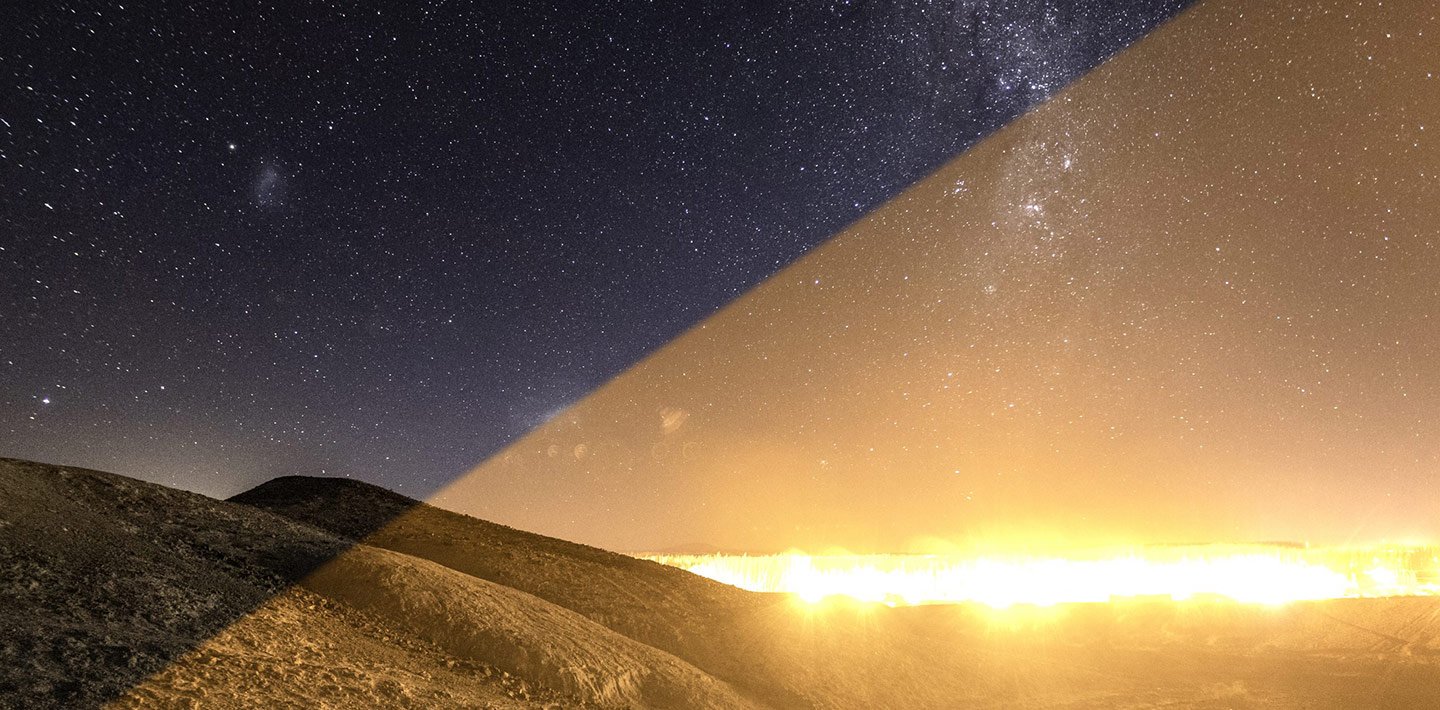
Glossary
A glossary of terms used throughout this site to describe lighting and its effects.

We include in this glossary definitions for a number of the basic terms and words used in the lighting community. For further information and formal definitions, please see discussions in standard dictionaries, encyclopedias, the ANSI/IES LS-1-22, Lighting Science: Nomenclature and Definitions for Illuminating Engineering (published by our partner the Illuminating Engineering Society), and other lighting industry books.
Skip below to:
A | B | C | D | E | F | G | H | I | J | K | L | M | N | O | P | Q | R | S | T | U | V | W | X | Y | Z
A
accent lighting
Lighting used to emphasize or draw attention to a special object or building.
adaptive controls
Devices such as motion sensors, timers, and dimmers used in concert with outdoor lighting equipment to vary the intensity or duration of operation of lighting.
ALAN
Acronym for artificial light at night.
ambient light
The general overall level of lighting in an area.
angstrom
A unit of wavelength often used in astronomy, equal to 10-10 meter or 0.1 nanometer.
artificial light
Light produced by humans.
Examples include electric light as well as the light from campfires, candles, and fireworks.
astrophotography
Also known as astronomical imaging, astrophotography is the photography or imaging of astronomical objects, celestial events, or areas of the night sky.
B
baffle
An opaque or translucent element used to shield a light source from direct view.
ballast
A device used with a discharge lamp to obtain the necessary voltage, current, and/or wave form for starting and operating the lamp.
beam spread
The angle between the two directions in the plane in which the intensity is equal to a given percentage (usually 10 percent) of the maximum beam intensity.
brightness
The strength of the sensation that results from viewing surfaces from which light comes to the eye.
bulb or lamp
The source of electric light. To be distinguished from the whole assembly (see luminaire). Lamp often is used to denote the bulb and its housing.
C
candela (cd)
Unit of luminous intensity. One candela is one lumen per steradian.
candlepower
Luminous intensity expressed in candelas.
candlepower distribution curve
A plot of the variation in luminous intensity of a lamp or luminaire.
CIE
Commission Internationale de l’Eclairage (International Commission on Illumination). An international technical, scientific, and cultural non-profit organization that sets lighting standards.
clutter
Bright, confusing, and excessive groupings of light sources.
color rendering
Effect of a light source on the color appearance of objects in comparison with their color appearance under normal daylighting.
color rendering index (CRI)
A measure of the accuracy with which a light source of a particular correlated color temperature (CCT) renders different colors in comparison to a reference light source with the same CCT.
color spectrum
The portion of the electromagnetic spectrum that is visible to the human eye, i.e., from about 380 nm to about 760 nm.
cones and rods
Two types of light-sensitive cells in the retinas of animal eyes. Cones dominate the response when the ambient light level is high, and provide color perception. Rods dominate at low ambient light levels and give no color perception.
conspicuity
The capacity of a signal to stand out in relation to its background such that it may be readily discerned by the eye (as in lettering on a sign, for example).
correlated color temperature (CCT)
A measure (in kelvins, K) of the warmth or coolness of the appearance of a light source. Light sources with a CCT of less than 3200 K are yellowish, pinkish, or orange-white in tone and considered “warm” in appearance. Light sources with a CCT greater than 4000 K are bluish-white and considered “cool” in appearance.
cosine law
Illuminance on a surface varies as the cosine of the angle of incidence of the light. The inverse-square law and the cosine law can be combined.
cut off angle of a luminaire
The angle, measured up from nadir (straight down), between the vertical axis and the first line of sight at which the bare source (the bulb or lamp) is not visible.
cutoff fixture
Old IES definition: Luminaire light distribution where the candela values per 1,000 lumens do not exceed 25 (2.5%) at or above an angle of 90 degrees above nadir, and the candela values per 1,000 lumens do not exceed 100 (10%) at or above 80 degrees above nadir. Note: The cutoff system for describing outdoor luminaires is deprecated. It was replaced in 2007 with the IES Luminaire Classification System and BUG ratings (refer to ANSI/IES TM-15-20, Technical Memorandum: Luminaire Classification System for Outdoor Luminaires).
D
dark adaptation
The process by which the eye becomes adapted to a luminance less than about 0.03 candelas per square meter (0.03 nits).
dark sky
Denoting or located in a place where the darkness of the night sky is relatively free of interference from artificial light.
DarkSky
A nonprofit organization building awareness of the value of dark skies, and of the need for quality outdoor lighting. The awesome organization whose website you are looking at, formerly known as the International Dark-Sky Association. Learn more about us.
diffuser
A device used to distribute and spread light from a source.
dimmer
A device used to reduce the light output of many kinds of light sources.
disability glare
Glare that results in reduced visual performance. It is often accompanied by discomfort.
discomfort glare
Glare that produces discomfort, but does not necessarily diminish visual performance.
E
efficacy
In lighting: the ratio of light output to its consumption of power, measured in lumens per watt (lm/W), or the ability of a lighting system to produce the desired result.
efficiency
A measure of the effective or useful output of a system compared to the input of the system, expressed as a percentage.
electromagnetic (EM) spectrum
The distribution of energy emitted by a radiant source, arranged in order of wavelength or frequency. Includes gamma-ray, X-ray, ultraviolet, visual, infrared, and radio regions.
energy (radiant energy)
Unit is erg, or joule, or kilowatt-hour (kWh).
F
façade lighting
The illumination of the exterior of a building.
Five Principles
Refers to the Five Principles of Responsible Outdoor Lighting developed jointly by the IES and DarkSky.
fixture
As used on this site, a light fixture or luminaire. It includes the elements designed to give light output control, such as a reflector (mirror) and/or refractor (lens), the ballast or driver, housing, and the attachment parts.
fixture lumens
A light fixture’s emitted light output.
fixture watts
The total power consumed by a fixture. This includes the power consumed by the light source(s) and the ballast(s) or driver(s).
floodlight
A fixture designed to “flood“ a well defined area with light.
flux (radiant flux)
Unit is ergs per second or watts.
footcandle (fc)
A unit of illuminance. One lumen per square foot.
footlambert
An older, deprecated unit for luminance, replaced by candelas per square meter, or nits.
full-cutoff fixture
Old IES definition: Luminaire light distribution where the candela values at 90 degrees or above are zero. Additionally, the candela values per 1,000 lumens do not exceed 100 (10%) at or above 80 degrees above nadir. Note: The cutoff system for describing outdoor luminaires is deprecated. It was replaced in 2007 with the IES Luminaire Classification System and BUG ratings (refer to ANSI/IES TM-15-20, Technical Memorandum: Luminaire Classification System for Outdoor Luminaires).
fully shielded
A fixture that allows no emission above a horizontal plane passing through the lowest light-emitting part of the fixture.
G
glare
Intense and blinding light that reduces visibility. A light within the field of vision that is brighter than the brightness to which the eyes are adapted.
H
HID lamp
A high-intensity discharge (HID) lamp is a type of discharge lamp where the emitted light is produced by the passage of an electric current through a gas concentrated in an arc tube. HID lamp types include mercury, metal halide, and high-pressure sodium.
high-pressure sodium (HPS) lamp
An HID lamp where radiation is produced from sodium vapor at relatively high partial pressures (100 torr).
house-side shield
Opaque material applied to the rear side of a fixture to minimize the light emitted behind the fixture.
I
IES
The Illuminating Engineering Society.
illuminance
Density of luminous flux incident on a surface. Unit is lux or footcandle.
Illuminating Engineering Society (IES)
In North America, the primary professional society of lighting engineers, designers, and other lighting professionals; headquartered in New York City, U.S.. Visit their website.
incandescent lamp
A lamp that produces light from a filament heated to a high temperature by electric current.
infrared radiation
Electromagnetic radiation with longer wavelengths than those of visible light, extending from the nominal red edge of the visible spectrum at 760 nanometers to 1 mm.
intensity
As used on this site: luminous intensity, i.e., the concentration of the light emitted from a point source or from a source that is far enough away to act as a point source. Unit: candela.
International Dark-Sky Association (IDA)
The former name of DarkSky.
inverse-square law
The equation used to determine illuminance on a surface from a light source (assumed to be a point source) a given distance away. The illuminance, E, at a point varies directly with the intensity, I, of the point source and inversely as the square of the distance, d, to the source. E = I / d^2. This assumes that the light is arriving normal to the surface. If the light is arriving at an incident angle other than 90 degrees, the resulting illuminance varies with the cosine of the angle.
J
K
kelvin (K)
The unit of thermodynamic temperature. 1 kelvin is equal in size to 1 degree on the Celsius scale. 0 K is absolute zero, or -273 degrees C. Learn more at Britannica.
kilowatt (kW)
A measure equal to 1,000 watts of electrical power.
kilowatt-hour (kWh)
A measure of electrical energy equivalent to a power consumption of 1,000 watts for 1 hour.
L
lamp
The source of light in an electric light fixture or luminaire. To be distinguished from the whole assembly (see luminaire). Lamp often is used to denote the bulb and its housing.
lamp life
The median life span for a specific type of lamp. Half of the lamps in a large sample will perform longer than the rated life; the others will fail sooner.
LED
Light-emitting diode.
light pollution
As used in this site: The human-made alteration of outdoor light levels from those occurring naturally. Learn more.
light quality
A measure of likely visual comfort and visual performance based on the lighting; considers the distribution, glare, color rendering, and other characteristics of the light.
light spill
Unwanted spillage of light onto adjacent areas, particularly residential properties and ecological sites.
light trespass
Light falling where it is not wanted or needed. Sometimes called spill light or obtrusive light.
lighting controls
Devices used for controlling when and how much light is emitted from a light fixture or lighting system; examples include dimmers, switches, and timers.
lighting zones (LZ)
The five base (or ambient) light levels desired by a community. See Lighting zones for more info.
Low-pressure sodium (LPS) lamp
A type of discharge lamp where the light is produced by radiation from sodium vapor at a relatively low partial pressure (about 0.001 torr). LPS is a “tube source.” It is monochromatic yellow light.
lumen
A measurement unit for the luminous flux generated by a light source, defined as the flux emitted within a unit solid angle by a point source with a uniform luminous intensity of one candela. Essentially, a measure of the total flow of light from a lamp, luminaire, or other light source, without regard to its directionality.
lumen depreciation factor
Light loss of a luminaire with time due to the lamp decreasing in efficiency as it ages.
luminaire
A complete lighting unit that usually includes the light source, the electrical driver for the source, the optical reflectors and/or refractors, and the housing to protect the light source. Also called a “light fixture.”
luminaire efficiency
The ratio of the light emitted by the luminaire compared to the light emitted by the enclosed lamps.
luminance
At a point and in a given direction, the luminous intensity produced by an element of the surface surrounding the point divided by the area of the projection of the element on a plane perpendicular to the given direction. Essentially, a measure of the brightness of an area, whereas luminous intensity (or just intensity) is a measure of the brightness of a point source. Units: candelas per square meter, or nits.
lux
A unit of illuminance: one lumen per square meter.
M
mercury vapor lamp
A type of HID lamp where the light is produced by radiation from mercury vapor. Mercury vapor lamps are no longer manufactured or sold in many parts of the world.
metal halide lamp
A type of HID lamp where the light is produced by radiation from metal-halide vapors.
mounting height
The height of the bottom of a fixture above the ground.
N
nadir
In lighting, nadir indicates the direction straight down from a luminaire (vertical angle 0 degrees), whereas zenith indicates the direction straight up from a luminaire (vertical angle 180 degrees).
nanometer (nm)
10-9 meter. Often used as the unit for wavelength in the electromagnetic (EM) spectrum.
O
occupancy sensors
A type of lighting control system that turns lights on and/or off based on the presence of people or other animals. There are two types:
- Passive infrared — A lighting control system that uses infrared beams to sense motion. When beams of infrared light are interrupted by movement, the sensor turns on the lighting system. If no movement is sensed after a predetermined period, the system turns the lights off.
- Ultrasonic — A lighting control system using high-frequency sound waves pulsed through a space to detect movement by depth perception. When the frequency of the sound waves changes, the sensor turns the lighting system on. After a predetermined time with no movement, the system turns the lights off.
optics
The components of a luminaire, such as reflectors and refractors, that make up the light emitting section.
P
photometry
The measurement of light.
photocell
An electronic device that changes the light output of a luminaire dynamically in response to the ambient light level around the luminaire.
photocell
A type of sensor that turns light fixtures on and off in response to the light received by the sensor. Some advanced types can slowly dim or increase the lighting. See also: Adaptive Controls.
phototaxis
The movement or direction of a living organism toward a light source as a behavioral response to changes in illuminance and the spectrum of the incident light. When attracted by or directed toward the light source, the behavior is called positive phototaxis, while avoidance or repulsion is called negative phototaxis.
Q
quality of light
A subjective ratio of the pluses to the minuses of any lighting installation.
R
reflected light
As used on this site: Light that is redirected back into the sky after bouncing off of illuminated surfaces such as cars, streets, parking lots, and roofs.
reflector
An optic that achieves control of light by means of reflection using mirrors or other highly polished surfaces.
refractor
An optic that achieves control of light by means of refraction using lenses.
S
semi-cutoff fixture
Old IES definition: Luminaire light distribution where the candela values per 1,000 lumens do not exceed 50 (5%) at or above an angle of 90 degrees above nadir, and the candela values per 1,000 lumens do not exceed 200 (20%) at or above 80 degrees above nadir. Note: The cutoff system for describing outdoor luminaires is deprecated. It was replaced in 2007 with the IES Luminaire Classification System and BUG ratings (refer to ANSI/IES TM-15-20, Technical Memorandum: Luminaire Classification System for Outdoor Luminaires).
shielding
An opaque material that blocks the transmission of light.
sky glow
The brightening of the night sky that results from the scattering and reflection of light from the constituents of the atmosphere (gaseous molecules and aerosols), in the direction of the observer. It has two separate components: natural sky glow and artificial sky glow.
spotlight
A fixture designed to light only a small, well-defined area.
stray light
Emitted light that falls away from the area where it is needed or wanted. Light trespass.
T
task lighting
Lighting used to provide direct light for specific activities without illuminating the surrounding area.
U
ultraviolet light
Electromagnetic radiation with wavelengths from 10 nm to 400 nm; UV wavelengths are shorter than those of visible light but longer than X-ray wavelengths.
V
veiling luminance
An apparent luminance produced by bright light sources in the field of view that is superimposed on the image in the eye, reducing contrast and hence visibility.
visibility
Capable of being perceived by the eye.
W
wallpack
A type of luminaire that is typically affixed to the side of a structure and used for area lighting.
watt
The standard unit of power in the International System of Units (SI), equal to 1 joule per second.
X
Y
Z
zenith
In lighting, zenith indicates the direction straight up from a luminaire (vertical angle 180 degrees), whereas nadir indicates the direction straight down from a luminaire (vertical angle 0 degrees).


















